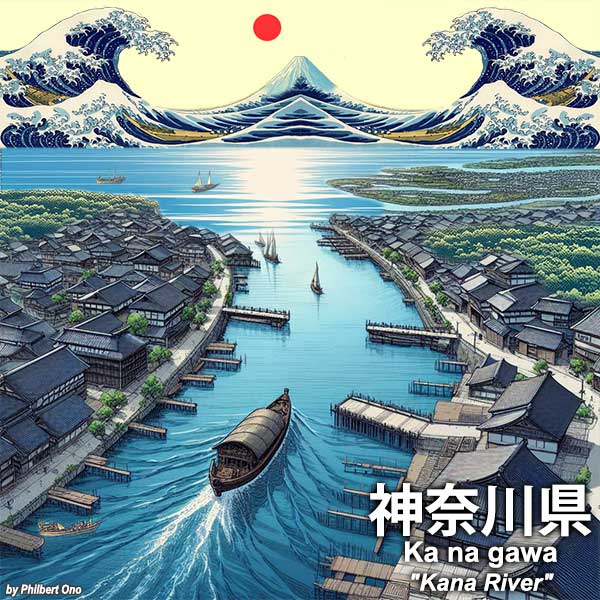KANAGAWA – Kana River 神奈川県

Like many prefectural names, Kanagawa has multiple theories as to its origin and meaning. Although Kanagawa sounds like the name of a river, there’s no river named “Kanagawa” today. It’s only a place name, like “Ishikawa” (Stone River).
“Kanagawa” is a well-known place name internationally since the treaty opening up Japan to the rest of the world in the 19th century was named after Kanagawa (Yokohama) where the treaty was signed (The Treaty of Kanagawa or Japan-US Treaty of Peace and Amity 日米修好通商条約).
Kanagawa was also the name of Kanagawa-juku, the third lodging town or station on the old Tokaido Road starting at Nihonbashi Bridge in Edo/Tokyo leading to Kyoto.
Hokusai’s most iconic woodblock print titled Great Wave of Kanagawa has also boosted international fame of the place name.
The earliest known document where “Kanagawa” appears is a directive dated 1266 from Hōjō Tokimune (head of the Kamakura samurai government) in the collection of Tsurugaoka Hachimangu Shrine in Kamakura. It mentions a hamlet named “Kanagawa-go” in kanji characters (神奈河郷). Kanji variants included 神名川 and 上無川.
The hamlet was within the shrine’s estate in the southern part of present-day Kanagawa-ku, Yokohama. It would eventually encompass the Kanagawa-juku lodging town on the Tokaido Road and Kanagawa Minato Port (神奈川湊). Kanagawa thereby became an important transportation center for land and sea.
When Yokohama was opened to American ships in 1859, the Tokugawa samurai government created the Kanagawa Bugyosho commissioner’s office (神奈川奉行所) to oversee the operation of Kanagawa Port. This office became the de facto local government office and changed its name to Kanagawa-fu (神奈川府) in August 1868 to create a local government after the demise of the samurai government. In September 1868, the office changed its name to Kanagawa Prefecture (神奈川県) which has remained till this day.
Kanagawa Prefecture underwent mergers and separations with other small prefectures and districts until present-day boundaries were established in 1893.
The meaning and origin of “Kanagawa” remains complicated and inexact. There are multiple theories:
Theory 1: The kanji characters for “Kanagawa” might have originally been 金川 literally meaning “Metal River.” It might have referred to Katabira River (帷子川) being rust-colored due to the river sand containing iron in the loam soil.
This river still runs through Yokohama. Kanagawa was a cluster of villages fronting the port area at the mouth of Katabira River that emptied into Tokyo Bay. Today, the river mouth is right near JR Yokohama Station.
Theory 2: The kanji characters for “Kanagawa” might have originally been 上無川 pronounced “Kami-nashi-gawa” meaning “No Upstream River.” This might have referred to a river with little or no water on the upper reaches or maybe the river’s origin was unknown since the area had so little rain.
Theory 3: The kanji characters for “Kanagawa” might have originally been 韓川 pronounced “Kanmekawa” or “Kankawa” meaning “Korean River.” This refers to the large population of immigrants from the Korean peninsula who were living in the area.
Japanese Wikipedia also mentions that “Kanagawa” was the name of a small river that was near Higashi Kanagawa Station on the Keikyu Line in Kanagawa-ku, Yokohama. It has since been filled in as part of the road. Hard to believe that they would bury such a historically important river…
Old province names: Sagami-no-Kuni, Musashi-no-Kuni (相模国+武蔵国)
*The AI-generated image is for illustrative purposes only and may not accurately depict any particular place in the prefecture.
Sources: https://www.pref.kanagawa.jp/docs/ie2/cnt/f530001/p780104.html
https://ja.wikipedia.org/wiki/%E5%B8%B7%E5%AD%90%E5%B7%9D
Origin of other prefectural names (etymologies)
Overview | Aichi | Akita | Aomori | Chiba | Ehime | Fukui | Fukuoka | Fukushima | Gifu | Gunma | Hiroshima | Hokkaido | Hyogo | Ibaraki | Ishikawa | Iwate | Kagawa | Kagoshima | Kanagawa | Kochi | Kumamoto | Kyoto | Mie | Miyagi | Miyazaki | Nagano | Nagasaki | Nara | Niigata | Oita | Okayama | Okinawa | Osaka | Saga | Saitama | Shiga | Shimane | Shizuoka | Tochigi | Tokushima | Tokyo | Tottori | Toyama | Wakayama | Yamagata | Yamaguchi | Yamanashi